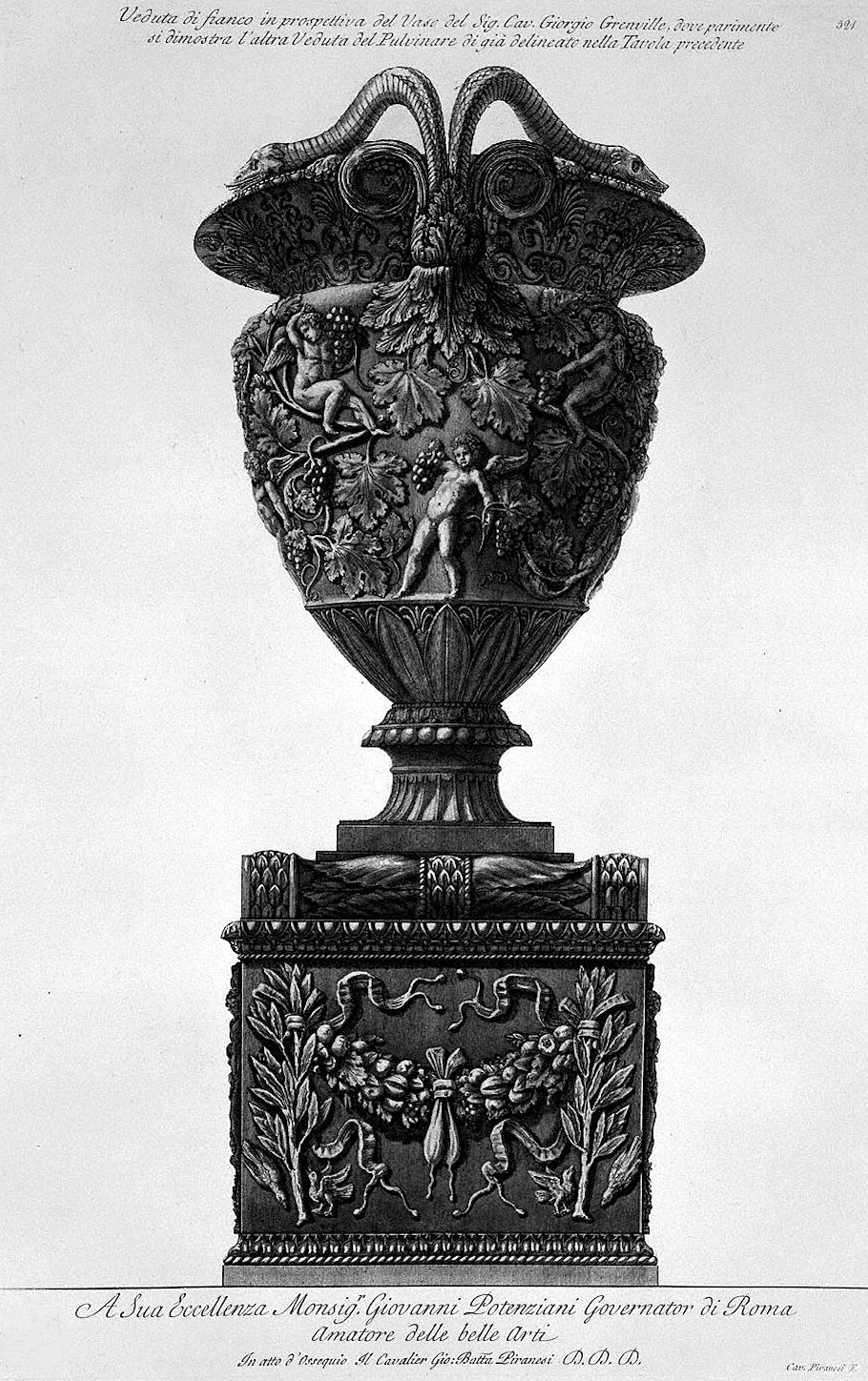26 January 1778 Monday
Vases, Candelabra, Grave Stones, Sarcophagi. Tripods, Lamps and Ancient Ornaments volume I

Side view in perspective of the aforesaid vase.
Side view in perspective of the Vase of Mr. Cav. Giorgio Grenville, where the other View of the Pulvinare already outlined in the previous Table is equally demonstrated
Cav. Piranesi F.
26 January 1812 Sunday

Morning thick fog, calm. Therm. 37° rose to 40°.Fog continued all day. The state of my knee and ankle rendered me unfit to go to meeting. S & SL and H. went. Rachel Hunt and some companions from Derby were there. Dr. Moore visited me in the afternoon, advised patience, nothing but rest will heal a strain. The fields are getting bare of snow in large spots. The roads bare and sloppy, not deep.
26 January 2000
the body in architecture
Brian wrote:
I've missed the whole 'body' debate, not really having an understanding of its relation to architecture. Maybe someone on list can share what they know.
Steve replies:
Brian, you might find a series of essays in Anthony Vidler's The Architectural Uncanny (1992) of some interest -- there's a section on bodies. These essays provide a somewhat broad overview of the latest (trendy -- for the late 80s late 90s anyway) architecture cum body thinking. As you know, I have my own theory about the body -- chronosomatics -- and I also have an extended idea of how then the body chronosomatically effects architecture, for example, the way I interpreted your AE thesis vis-a-vis the lowest tips of the rib cage and the heart.
Regarding body 'modification', I personally think the Bellonarii, the priests and priestesses of Bellona, the goddess of war, who were accustomed, in their mystic festivals, especially on the 20th of March (hence dies sanguinis, day of blood), to gash their arms and shoulders with knives, and thus to offer their blood, are still more meaningful as to the use of their bodies than any of the stuff going on and hyped today. Of course, I'm a bit predisposed in this regard since the 20th of March is my birthday (1956), and the day my brother Otto George underwent a couple brain operations (1980).
26 January 2001
irony and feeling
I like the second to last paragraph of Holl's "Phenomena and Idea":
"Easily grasped images are the signature of today's culture of consumer architecture. Subtle experiences of perception as well as intellectual intensity are overshadowed by familiarity. A resistance to commercialism and repetition is not only necessary, it is essential to a culture of architecture."
I like this paragraph because it exposes a significant part of the soft underbelly of what might, for convenience's sake, be called architecture's ongoing 'classism'. The 'racism' of Western architecture has already rendered substantial irreparable damage, i.e., first via colonialism, and then via the International Style, and now architecture 'classism', which Holl provides a glimpse of so succinctly, is practiced as well as highly sanctioned. If it hasn't already happened, I think it's time someone started writing an 'equal-rights amendment' for architecture.
irony and feeling
To answer your question, I'm trying to come to grips with the notion of why European colonials didn't simply accept the architectures that were indigenous to the lands that they (the Europeans) colonized. I see this as a negative action because I think a case can be made that many of this planets indigenous architectures are now virtually extinct because of Western colonialism/imperialism. During the first half of the 20th century, while large parts of the world were still colonies of Europe, Western modern architecture or the International Style (again a term used more for convenience) continued the global domination of Western style and furthered the extinction of indigenous architectures.
As much as I like Classical Greek and Roman architecture and Modern architecture, I nonetheless see it as a tremendous loss to architecture in general that these styles are now so global at what seems to be the expense of so many other architectures. This is why I am less and less tolerant of architectural criticism/theory that goes to far as to say "this architecture here is good" but "that architecture over there is bad."
In a recent post, you mentioned that commercialism may be readily acceptable to the post W.W.II generations, but I have to wonder whether the end of colonialism and the US civil rights movement are a better benchmark for the acceptability of diversity in all its guises.
ps
When I first thought up the quote, "The whiter humanity thinks, the more it manifests extinctions," I was thinking of architecture.
irony and feeling
And I think you assume too much that I'm being "post-modern". I was speaking about architecture [and] using other terms for convenience. Everything you said was about broader cultural issues, but you said nothing about the architectural issues I raised. You changed the subject.
I am not seeking apologies or ways to change the past. I just don't want to see present or future architecture's succumb to further "Western" theoretical dominance, especially against diversity.
You bring up assimilation, but you don't mention that the assimilation of colonialism was a forced assimilation. In architectural terms, the 'purism' of early modernism was/is a form of assimilation in the extreme, namely purge. Global assimilation is one of today's dominant cultural aspects, but extreme assimilation like that of the last century is not a lasting aspect of humanity.
Part of my thinking is also given as a kind of preparatory warning. With genetic engineering becoming more and more a common science, humanity will find itself in the next century or so having to think real hard about diversity and individuality. Some forethought in this area is certainly not going to hurt. Imagine what might happen if the genetic engineers of tomorrow were trained to design like today's architects.
the couch is on eBay again
...as to Larson's book. he's been around since 1994(?) when Progressive Architecture published the Hurva Synagogue images. I was always suspicious of him, however, because he received a grant from the Graham Foundation (I don't know what year) to do the Hurva computer model. In 1991, I applied to the Graham for a grant to do the same thing, along with many other buildings. Of course, I never received the grant, and I wonder whether Larson or someone else read my grant proposal, and since Larson was/is associated with MIT, he got the grant. If Julia Converse, curator of the Kahn archives, ever admitted it, she'd have to say that in 1985 I requested to see all the drawings of Kahn's (unbuilt) Dominican convent, and I then started to build a computer model in my spare time on Penn's GSFA Intergraph system. The GSFA sold their cad system in early 1987, and since at that time there was no way to translate the data, the model I worked on was lost. I still have photocopies of the Kahn office drawings I used to build the model, however.
26 January 2002
Re: WTC Recycled Steel
Again, where is that study on 'architecture that moves' when you need?
Did anyone complain when pieces of the Berlin Wall were up for sale as souvenirs? Concrete is real cheap though, isn't it?
Schumpeter called capitalism "creative destruction," however "destructive creation" seems more apt (today at least).
The (chronosomatically forthcoming) liver is the most metabolic organ of our bodies.
26 January 2015
Aaron Betsky To Lead Taliesin West
"In the Zeitgeist, everything will be the future."
26 January 2016

paradigm shifting architectures of closely related imperials plans
26 January 2023 Thursday
. . . . . .
|